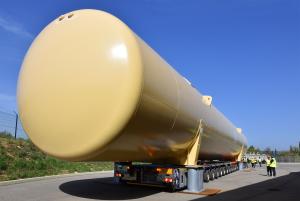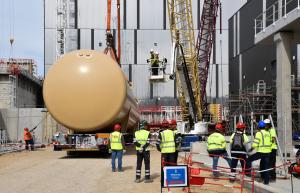Image of the week
Moving into place
23 Apr 2018
The two quench tanks that were sitting in the holding area on the edge of the ITER premises near the car park moved onto the ITER platform today.
A remotely handled self-propelled modular transporter with 18 independently manoeuvrable axles took one tank to its final destination just outside the cryoplant building. The second tank, already transferred onto the platform, will join its twin later this week.
With their dimensions of 35 metres in length and almost five metres in diameter, and weighing 163 tonnes each, the twin tanks are among the largest components of the cryoplant. They are integral parts of the cryogenic system, designed to hold helium from the Tokamak's magnetic system in case of a sudden loss of superconductivity (a quench).



